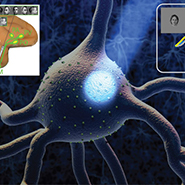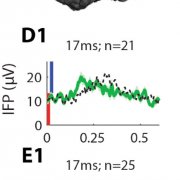Visual recognition takes a small fraction of a second and relies on the cascade of signals along the ventral visual stream. Given the rapid path through multiple processing steps between photoreceptors and higher visual areas, information must progress from stage to stage very quickly. This rapid progression of information suggests that fine temporal details of the neural response may be important to the brain’s encoding of visual signals. To further understand the mechanisms subserving recognition (“What/Who is there?”), we are investigating how changes in the relative timing of incoming visual stimulation affect the representation of object information by recording intracranial field potentials along the human ventral visual stream while subjects recognize objects whose parts are presented with varying asynchrony. We have observed that visual responses along the ventral stream were sensitive to timing differences between parts as small as 17 ms. In particular, there was a strong dependency on the temporal order of stimulus presentation, even at short asynchronies. This sensitivity to the order of stimulus presentation provides evidence that the brain may use differences in relative timing as a means of representing information.
Neural Circuits for Intelligence
 Abstract thinking and complex problem solving constitute paradigmatic examples of computation emerging from interconnected neuronal circuits. The biological hardware represents the output of millions of years of evolution leading to neuronal circuits that provide fast, efficient, and fault-tolerant solutions to complex problems. Progress toward a quantitative understanding of emergent intelligent computations in cortical circuits faces several empirical challenges (e.g., simultaneous recording and analysis of large ensembles of neurons and their interactions), and theoretical challenges (e.g., mathematical synthesis and modeling of the neuronal ensemble activity). Our team of theoreticians and neurophysiologists is focused on systematic, novel, and integrative approaches to deciphering the neuronal circuits underlying intelligence. Understanding neuronal circuits that implement solutions to complex challenges is an essential part of scientific reductionism, leading to insights useful for developing intelligent machines.
Abstract thinking and complex problem solving constitute paradigmatic examples of computation emerging from interconnected neuronal circuits. The biological hardware represents the output of millions of years of evolution leading to neuronal circuits that provide fast, efficient, and fault-tolerant solutions to complex problems. Progress toward a quantitative understanding of emergent intelligent computations in cortical circuits faces several empirical challenges (e.g., simultaneous recording and analysis of large ensembles of neurons and their interactions), and theoretical challenges (e.g., mathematical synthesis and modeling of the neuronal ensemble activity). Our team of theoreticians and neurophysiologists is focused on systematic, novel, and integrative approaches to deciphering the neuronal circuits underlying intelligence. Understanding neuronal circuits that implement solutions to complex challenges is an essential part of scientific reductionism, leading to insights useful for developing intelligent machines.

